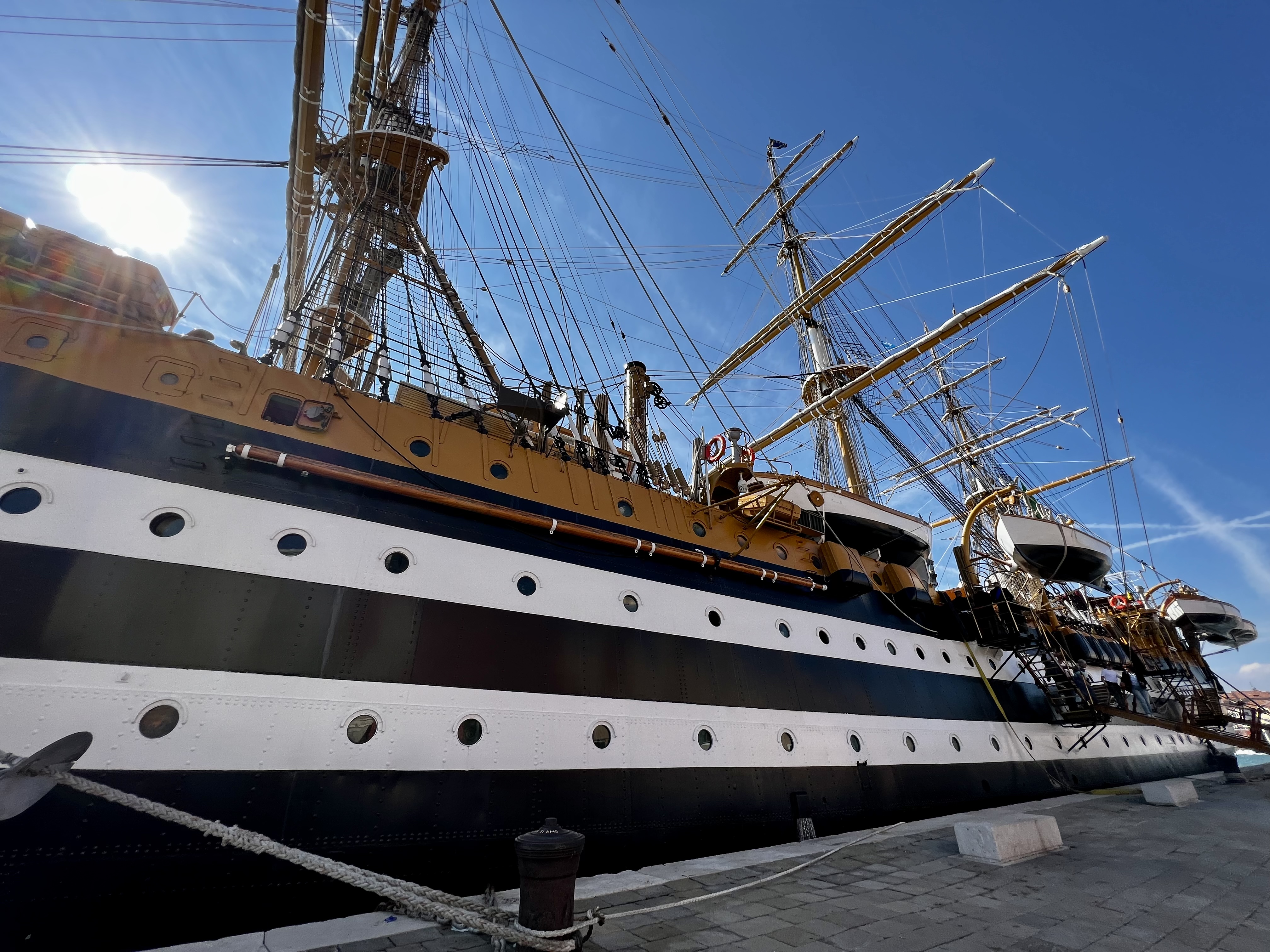The historic ship “Amerigo Vespucci” has docked for the 27th time in Venice, on the occasion of the thirteenth edition of the "Trans-Regional Seapower Symposium of the wider Mediterranean" (XIII T-RSS), an international maritime forum to be held from 5 to 7 October at the Venice Arsenal, with an attendance of over 60 navies and 80 international organisations interested in maritime issues. Unicef ambassador since September 2007, the “Vespucci” was described by the Americans in the 1970s as "the most beautiful ship in the world".
Designed in the late 1920s by Francesco Rotundi, engineer and Lieutenant Colonel of the Naval Engineers, the “Vespucci” was set up in the Castellammare di Stabia shipyard on 30 May 1930, launched on 22 February 1931 and delivered to the Italian Navy on 2 July of the same year. At 91 years of age, the “Vespucci” is the 'oldest' ship in the entire Italian Navy.
It is a powered sailing ship with three vertical masts plus an oblique bowsprit at the bow, which acts as a fourth mast. The crew normally consists of around 260 military personnel, 40 of whom are women. Still, in the summer period - with the arrival of students and staff from the Naval Academy - the crew exceeds 400 people. From 2014 to 2016, the ship underwent modernisation works, which improved its operational capabilities and logistical arrangements. The power generation and propulsion apparatus were also completely replaced with technologically advanced, more efficient and strictly environmentally oriented components.
Indeed, it is a ship with an ancient flavour, because sailing on the “Vespucci” is like cutting through the waves aboard a 17th-century sailing ship. As a matter of fact, it is an exact reproduction of a sailing ship from the Reign of the Two Sicilies: from the captain's quarters to the most secret and elegant rooms, from the hammocks on which the Academy students sleep to the historic helm that requires eight crew members to move it one degree.
“The peculiarity of the helm is that it has no hydraulic or electrical components but transmits motion to the tiller through gears, it has four wheels on which eight people operate," explains its captain, Luigi Romagnoli. "This is the oldest ship of the Navy, and its added value is its slowness, because every activity here is done by hand by many people, with the strength of their arms and passion. This is where the new generations are taught to go to sea”.
“I like to say that in this ship there is an excellent combination of technology, tradition and innovation," says Sub-Lieutenant Federico Messini, who has been on board for four years. "The Naval Academy students come aboard the “Vespucci” for about three months and what they find here is their “baptism of the sea”: here, they learn to navigate with traditional instruments, the sextant, the compass, the nautical chart, compasses and a pencil, and to follow the stars. But, above all, when we go sailing everything we do is completely manual, nothing is mechanised. Like the opening of the sails which, unlike other traditional sailboats, do not go up but come down. Therefore, dozens of people climb to the top of the masts to untie the knots in the sails, and then to pull them back up".
The “Vespucci” predominantly employs 24 sails, 14 of which are square-rigged on the spars, and the other 10 are trimmed, for a total sail area of more than 2,700 square metres. The largest sail is 250 square metres, which is the size of a basketball court, and it takes the strength of the arms of many young people to furl it.
"Life on board follows a tight and well-defined schedule," explains Aurora Esposito, a marine guard aboard the “Vespucci”, who will soon become an officer of navigation. "My job is to advise the captain in choosing the routes, giving him my opinion on the best ones to follow according to the weather conditions in the stretch of sea where we are going. We are divided into teams that take turns on watch. Our day, therefore, revolves around the watches we make”. Waking up, participating in the assembly, cleaning the ship, sharing meals, but also sports and free time to read a book or watch a film. "I'm from Naples and when I was younger I used to see the students of the Nunziatella Military School and the Air Force Academy passing by in uniform. So, I asked my father, who also is in the military, what they did and he explained the course of study to me. Then, I attended military school and the academy because I became passionate about it”. Women have been in the Italian Navy for about 20 years, and today there is no distinction between the two sexes, not even in the tasks to be performed. "As in all the other areas, women bring added value," Esposito concludes, "because they see things differently from men, so multiple perspectives and moments of confrontation are created”.
The Vespucci can also be visited today from 7 to 10 PM, and on Thursday 6 October from 7 to 11 PM.
But the historic ship is not the only one in Venice: the San Marco, the Navy's amphibious assault unit, has docked in Riva Sette Martiri. It can be visited on Thursday 6 October 3-6 PM, and 9-11 PM, as well as on Friday 7 October 3-6 PM. All visits are free of charge and no booking is required.
Also present at the Symposium will be the Italian Navy band with 50 of its 102 elements, conducted by Maestro Antonio Barbagallo, who will perform on Thursday 6 October at 4 PM in Campo San Rocco with a concert featuring music from Verdi to Morricone.

